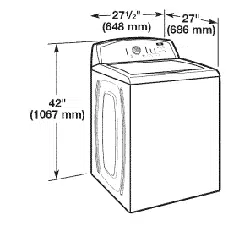Loading ...
Loading ...
Loading ...

if you experience
TROUBLESHOOTING
First try the solutions suggested here
for assistance and to possibly avoid a service call.
PosslbJe causes
incorrect or wrong
wash or rinse
temperatures
Dry spots on load High speed spins extract more
after cycle moisture than traditional top-load
washers.
Check for proper water supply.
Load not rinsed
Sand, pet hair, lint, etc.
on load after washing
Load is tangling
Not cleaning or
removing stains
Energy-saving controlled
wash temperatures.
Check for proper water supply.
Not using HE detergent or using too
much HE detergent.
Washer not loaded as recommended.
Heavy sand, pet hair, lint, and
detergent or bleach residues may
require additional rinsing.
Washer not loaded as recommended.
Added more water to washer.
Washer not loaded properly.
SoJutlon
The high spin speeds combined with air flow during the final spin
can cause items near the top of the load to develop dry spots
during the final spin. This is normal.
Make sure hot and cold inlet hoses are not reversed.
Both hoses must be attached to both washer and faucet, and
have both hot and cold water flowing to inlet valve.
Check that inlet valve screens are not clogged.
Remove any kinks in hoses.
ENERGY STARe qualified washers use cooler wash and rinse
water temperatures than traditional top-load washers. This
includes cooler hot and warm washes.
Make sure hot and cold inlet hoses are not reversed.
Both hoses must be attached and have water flowing to the
inlet valve.
Both hot and cold water faucets must be on.
Inlet valve screens on washer may be clogged.
Remove any kinks in the inlet hose.
The suds from regular detergent can keep washer from
operating correctly.
Use only HE detergent. Be sure to measure correctly.
Always measure detergent and follow detergent directions based
on load size and soil level.
The washer is less efficient at rinsing when load is tightly packed.
Load garments Jn loose heaps evenly around the washpiate. The
washer wJJJnot rinse well Jf tightly packed. Load with dry items
only.
Use cycle designed for the fabrics being washed.
Add only 1 or 2 garments after washer has started.
Add Two Rinses to the selected cycle.
See "Using Your Washer" section.
Select a cycle with a slower wash action and spin speed;
however, items wJJl be wetter than those using a higher speed spin.
See the "Cycle Guide" to match your load with the best cycle.
Load garments in loose heaps evenly around the washplate.
Reduce tangling by mixing types of load items. Use the
recommended cycle for the type of garments being washed.
Washer senses load size and adds correct amount of water. This
is normal and necessary for clothes to move. It is normal for the
wash load to be not completely covered in water. Added water
lifts the laundry off the washplate, resulting in besseffective
cleaning.
Washer is bess efficient at cleaning when load is tightly packed.
Load garments in loose heaps evenly around the washplate. Load
with dry items only.
Add only 1 or 2 garments after washer has started.
J
15
Loading ...
Loading ...
Loading ...
